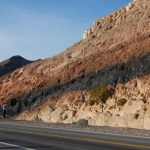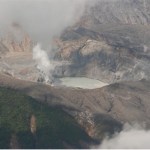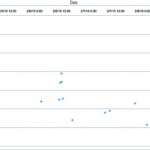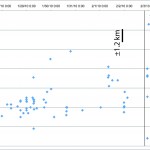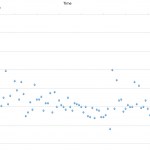speculation
Map showing the location of submarine volcano Marsili, near the Italian coast. Image from INGV.
The subject of submarine volcanism near Italy has come up before here on Eruptions but now it has made the jump into the worldwide media after some claims made by Enzo Boschi, president of the National Institute of Geophysics and Volcanology (INGV).
The long and short of what I can tell from the articles is that Marsili, a submarine volcano in the Tyrrhenian Sea, could be a threat to create a significant tsunami that would hit Italy (amongst other Mediterranean countries). The volcano lies only…
I'm still playing catch-up after my week in the desert, so I've seen a lot of articles I've wanted to mention ... but a certain other volcano has taken up a lot of my time. However, I will attempt to make amends for that now.
By the way, would you believe Ubehebe Crater was closed? How do they close a volcano, anyway? However, I did get a great snap of a welded tuff on the road outside of Shoshone, CA.
A strongly welded tuff near Shoshone, CA. The dark interior is remelted volcanic ash/tephra surrounded by less welded pink tuff with abundant pumice clasts. Denison student David Sisak is on…
The fissure vent eruption on Eyjafjallajokull in Iceland on March 21, 2010.
The big news this morning is the eruption that started last night at Eyjafjallajokull in Iceland, producing a 1-km fissure vent. The pictures and videos I've seen so far have been quite impressive, with the classic look of a "curtain of fire", where basaltic lava erupts explosively from a linear array of vents - you can see the geometry in the image from the BBC/AP (above). Especially clear is the dual nature of the eruption, with both the explosive fire fountains and the effusive (passive) lava flows from the root…
Leaving for Death Valley tomorrow - I'll be sure to take some pictures of Ubehebe Crater and the volcano at the Mirage. This will likely be the last new post until about a week from now, but look for the Erta'Ale Volcano Profile, maybe a new Mystery Volcano Photo and I'll leave a thread open for any new volcano news.
Colima in Mexico.
Eruptions reader Tim Stone sent me this image from Japanese astronaut Soichi Noguchi's Twitpic feed - it is a stunner of the caldera on Jebel Marra in Sudan. The only known historical eruption for this volcano was ~2000 BC within the Deriba Caldera, but it has…
Did I mention its a busy week?
The lava lake at Erta'Ale in 2008. Image courtesy of Stromboli Online.
Our Icelandic saga continues, with more earthquakes and more speculation/information on the parts of Eruptions readers. Keep up the discussion - I'll be fascinated to see who turns out to get closest to what actually happens, prediction-wise. The seismicity has quieted somewhat again in the last 12 hours, so we wait eagerly to see what comes next. Remember, Iceland is the land where volcanoes helped change history, so it is always fun to talk Icelandic volcanism.
The NASA Earth Observatory…
Cleaning up some news ... busy week leading up to a field trip I am helping co-lead to Death Valley next week.
Ubehebe Crater in Death Valley, California
First off, I want to say how amazed I am at the great discussion that went on all weekend about the signs of potential activity in Iceland. It now appears that the earthquakes at Eyjafjallajökull may be waning, however the levels of seismicity have definitely bounced up and down over the last few days. However, the level and depth of the conversation is a testament to all volcanophiles out there. Nice job, folks.
For those of you into…
Eyjafjallajökull, an ice-capped volcano in Iceland that last erupted in 1823.
We talked a few weeks ago of signs that there were increasing signs that an eruption could occur on Iceland - increased seismicity on the Reykjanes Ridge suggested that magma might be on the move. Now, we have two pieces of evidence that we might see activity at Eyjafjallajökull, on the southern side of the island nation.
First off, there is a focus of seismicity under the area of Eyjafjallajökull, with an especially large bump in the last 2 days. Both the number and magnitude of the seismicity has been marching…
Some news for a busy Tuesday:
The crater at Poas volcano in Costa Rica, taken February 25, 2010. Image courtesy of OVSICORI by Federico Chavarria.
After the MSNBC debacle, it is nice to see some good articles on why the Chilean earthquake was overall less disastrous than the Haitian earthquake, why the tsunami wasn't as large as predicted and why these earthquakes are not abnormal. There are a lot of factors involved - the location, depth, preparedness, wealth - so the comparison can be very telling in terms of both geologic and societal issues.
The other scientific fallout from the Chilean…
The Icelandic coast of Reykjanes where the Mid-Atlantic Ridge comes above sea level.
A number of Eruptions readers have noticed that seismicity along the Reykjanes Ridge that runs to the southwest of Iceland onto the island has increased over the last few days. Sure enough, checking the Icelandic Met Office page on seismicity on the island finds a lot of earthquakes on the southwest peninsula that is the manifestation of the Mid-Atlantic Ridge hitting the hotspot-related Icelandic landmass. The interaction between the Iceland plume and the Mid-Atlantic Ridge is complex, with a step in the…
The Great Earthquake Swarm at Yellowstone that ushered in 2010 seems to be dying down, at least according to the USGS earthquake reports and analysis of the seismicity by the University of Utah and YVO. The daily updates on the earthquake swarms by Utah has ended. Looking at the earthquake over the last 7 days (see below), you can notice three things quickly: (1) since 2/6, there are much fewer quakes compared to a week and a half ago; (2) any sign the earthquakes were getting shallower seems to have ended; and (3) they seem to be generally smaller ( M1.5). Now, what does that mean? Like many…
Steaming, gurgling mudpots in the active hydrothermal system of Yellowstone.
For those of you following Yellowstone (I think there might be a few of you), I've plotted up the earthquakes since 1/27 (see below) - and sure enough, although there is a lot of scatter, they are getting shallower - however what this exactly means is unclear. You can see my plots from 1/22-28 here. As many of you have mentioned, a caldera like Yellowstone is a big interconnected system, so a solely tectonic source of this is still possible as the displacement migrates through the fractured caldera rocks.
UPDATED…
There has been a ... ahem ... healthy discussion of Yellowstone's current earthquake swarm on Eruptions as of late. We've now reached ~1,500 measurable earthquakes over the last 11 days. The latest reports of the continuation of the swarm isn't going to make anyone happy, but still, there are no signs that (a) this is out of the ordinary and (b) indicates magma making its way to the surface. In fact, if you plot the earthquakes since the 22nd of January, the depth appears to getting, well, deeper:
This plot shows the earthquakes listed on the USGS earthquake page since January 22 (oldest to…
Old Faithful geyser at Yellowstone National Park.
A few thoughts about faulting, earthquakes and eruptions:
The earthquakes at Yellowstone have been universally attributed to fault movement rather than magmatic activity by the USGS and the researchers at the University of Utah. This is likely based on the moment solutions for the earthquakes (i.e., the sense of motion on the earthquake - side to side, dilation, etc.) and the fact that there are no directly correlative volcanic/magmatic symptoms to go with them (such as pronounced, short-term bulging, excessive hydrothermal venting, etc.) Now…
A hot spring in Yellowstone National Park. Image courtesy of the USGS.
Yesterday I left a little teaser about the current earthquake swarm going on at the Yellowstone Caldera. Eruptions readers have come through with even more information on the swarm. Over 250 earthquakes have occurred in the park over the last few days, most between 0.5-3.1 on the Richter Scale - and getting larger each day. The swarm is centered 10 miles northwest of Old Faithful, Wyoming and 9 miles southeast of West Yellowstone. However, before everyone gets too excited, Dr. Robert Smith of University of Utah (the go-to…
Busy busy today with the first day of spring semester classes, but ...
Yellowstone is having a nice little earthquake swarm, eh? Likely it is nothing beyond fluid flow as the earthquake are shallow, but hey, it is still fun to see.
The streaming crater of Turrialba in an image taken in mid January 2010.
I have a moment to spare here at WMU, so I thought I would pass some of this confusing news along concerning Turrialba. Some of the latest reports refer to a "crack" in the crater of the volcano ... specifically:
Geologists and volcanologists were at least able to confirm that the crack on the wall of the volcano is getting larger, confirmed by flybys by helicopters during a break in the weather. The experts say the constant spewing of gases is causing the crack to get bigger and could collapse the volcano's crater wall…
Last week, I reported that Karkar in Papua New Guinea had erupted. This was based on reports from Volcano Live and from the Darwin VAAC that said the volcano had produced at least 1, maybe 2, ~13 km / 45,000 foot ash columns. That is not a trivial ash column - you would think a large eruption was needed to produce such an ash column (and you'd be right).
Then, no news. Nothing. I (and other Eruptions readers) scoured the web for more information on this phantom eruption at Karkar. Not a peep on noise about any eruption, let alone an eruption to send ash above 40,000 feet.
Recent reports from…
Here is Part 2 of the Q&A with Dr. Boris Behncke. You can also check out Part 1.
Undated image of Stromboli in eruption.
(Shirakawa Akira) 1. Would a large scale eruption (VEI 5 or greater) of Mt. Etna like the ones occurred in 122 BC and 1500 BC (disputed) be possible again in the foreseeable future? Or is the volcano slowly "dying" although the last eruption ended in July 2009 has been one of the longest ever recorded?
2. Not really related to volcanism, but close: does INGV plan to distribute seismic data from seismic stations of its Rete Sismica Nazionale, including stations from…
Geologic and structural map showing the extent of the Campi Flegrei caldera on the north of the Bay of Naples, Italy. Image courtesy of INGV.
One of the writing assignments I always enjoyed in high school was the "compare and contrast". You could sit back and look for stylistic differences between writers and texts - potentially offering signs about the nature of the writers motivations.
I still find it fun - case in point, two article I read about the research drilling that is about to start at the Campei Flegrei in Italy. The Campei Flegrei is a large caldera system that most recently…
It seems like I've been stepping on a lot of people's toes lately, so in an effort to foster more camaraderie and less belligerence between the "old media" (this is not derogatory, but rather refers to anything pre-internet news source or classic journalistic source) and "new media" (this includes internet-era news sources, bloggers and the like), I'd like to put down my thoughts on the state of science journalism on the internet today.
I do not think all media is bad at science. There are a multitude of great science sources out there that handle the issues quite well, mostly associated…
